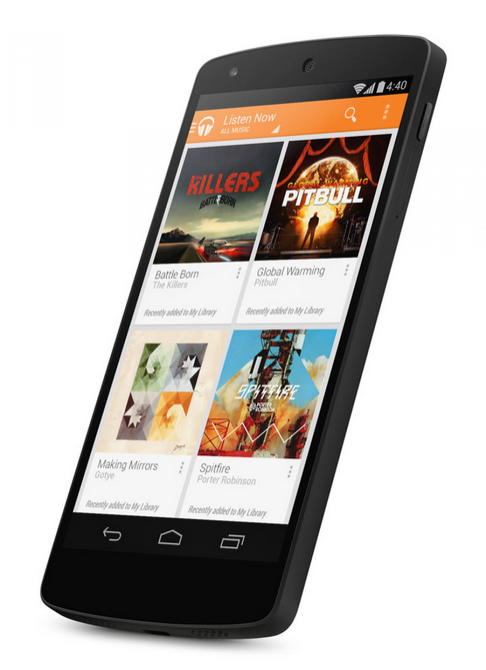LG Nexus 5 vs. LG G2 vs. Sony Xperia Z1 vs. Moto X: Android Smartphone Specs Shootout

How does the recently announced Nexus 5 from LG and Google (NASDAQ:GOOG) match up to its fellow Android smartphones? With a much lower off-contract purchase price, the Nexus 5 compares favorably with other Android smartphones, offering some of the same features found in the LG G2 and Moto X. However, a few of the competitors’ specs and features did not make the cut.
The latest smartphone from Google houses a processor comparable to many of the flagship devices available from hardware partner LG and Sony, and besting the dual-core Snapdragon chip inside of the Moto X, and its screen is as good if not better than much of the competition. Is the Nexus 5 the best Android smartphone on the market?

In an attempt to improve the Nexus 4’s oft-cited weaknesses – a low-resolution screen and lack of 4G-LTE connectivity – Google had hardware partner LG step the Nexus 5 up to Full HD 1080p resolution. To keep the Nexus 5 at a reasonable off-contract price point, Google had to cut some corners, and some tech blogs are already criticizing the Nexus 5 battery size at 2,300 mAh, as opposed to the 3,000 mAh found in other phones with a similar size footprint.
While the Nexus 5 bests the Moto X screen in size and resolution, its screen is smaller than the LG G2 and Xperia Z1. That means that it is smaller than the LG G2 and Sony Xperia Z1 in physical size, which some users may prefer. Ergonomics is often a personal distinction based on the user, but when the International Business Times reviewed the LG G2, we found that the relocated volume and power buttons (known as the Rear Key) were poorly implemented. The Nexus 5 fills a sweet spot as far as size is concerned, being only slightly larger than the Moto X, but not as enormous as the Xperia Z1 and G2. The bump to 1080p resolution means the Nexus 5 also has a higher pixel density than any of its recent competition as well.
Unfortunately, the screen on the Nexus 5 will be a bigger power draw than the 4.7-inch screen on the Moto X and Nexus 4, without much of a bump in battery size. The new full HD screen on the Nexus 5, coupled with LTE bands and a voice search feature that has the Nexus 5 listening for “OK, Google now” most of the time, means the Nexus 5 will not last as long on battery power as some of its rivals.
The Nexus 5 includes optical image stabilization (OIS), but takes lower-resolution pictures than many of its rivals, including the 20.7-megapixel Xperia Z1, 13-megapixel LG G2 and even the 10-megapixel Moto X. The only improvement in the Nexus 5 over its predecessor is OIS and a few new features, as the 2012 Nexus 4 also shot in 8-megapixels.
The Nexus 5 features wireless charging, whereas the Xperia Z1 and Moto X lack such a feature without the use of a separate case accessory. The LG G2 only includes it on its Verizon Wireless variant.
Both the Xperia Z1 and Moto X have water-resistant features, with Sony’s flagship offering full IP55/IP58 certification for dust- and water-proofing. The Moto X offers a less robust water-repellent coating on its surface and interior, whereas the LG G2 and Nexus 5 lack any kind of water resistance altogether.

Nexus 5 vs. Moto X vs. LG G2 vs. Sony Xperia Z1: Special Features
The Moto X has been touted for a series of special features that distinguish it from the competition, including active notifications that make use of the AMOLED screen for minimal power usage. Basically, the AMOLED sceen does not use power to display black, so the Moto X’s interactive touch notifications draw less power than their competitors. The Moto X also features a special gesture, where two flicks of the wrist open the camera app – even from a lock screen.
The LG G2 incorporates a “knock-knock” gesture, where a double-tap on the screen awakes the device from sleep mode. The Sony Xperia Z1 does not incorporate gestures, but features a dedicated camera button.
The Nexus 5 lacks any gesture features, and attempts to incorporate the active voice search found on the Moto X – although the Nexus 5 is not “always listening” like the Moto X, one report says it only responds to “OK, Google” from the home screen or within the search app. The real differentiator between the Nexus 5 and its competition, other than the distinctive size and stock Android 4.4 operating system, is its low price.
The Nexus 5 is not the flashiest flagship on the market – Android or otherwise – when it comes to specs or features. However, Google’s Nexus 5 is the most reasonably priced handset on the market by far, while still managing to incorporate a high-speed quad-core processor and full HD 1080p screen.
Have you ordered your Nexus 5 yet, or do you prefer the unique features found in the Moto X? Perhaps you prefer the expandable storage and large screen found on the Xperia Z1? Let us know in the comments below.
© Copyright IBTimes 2024. All rights reserved.





















